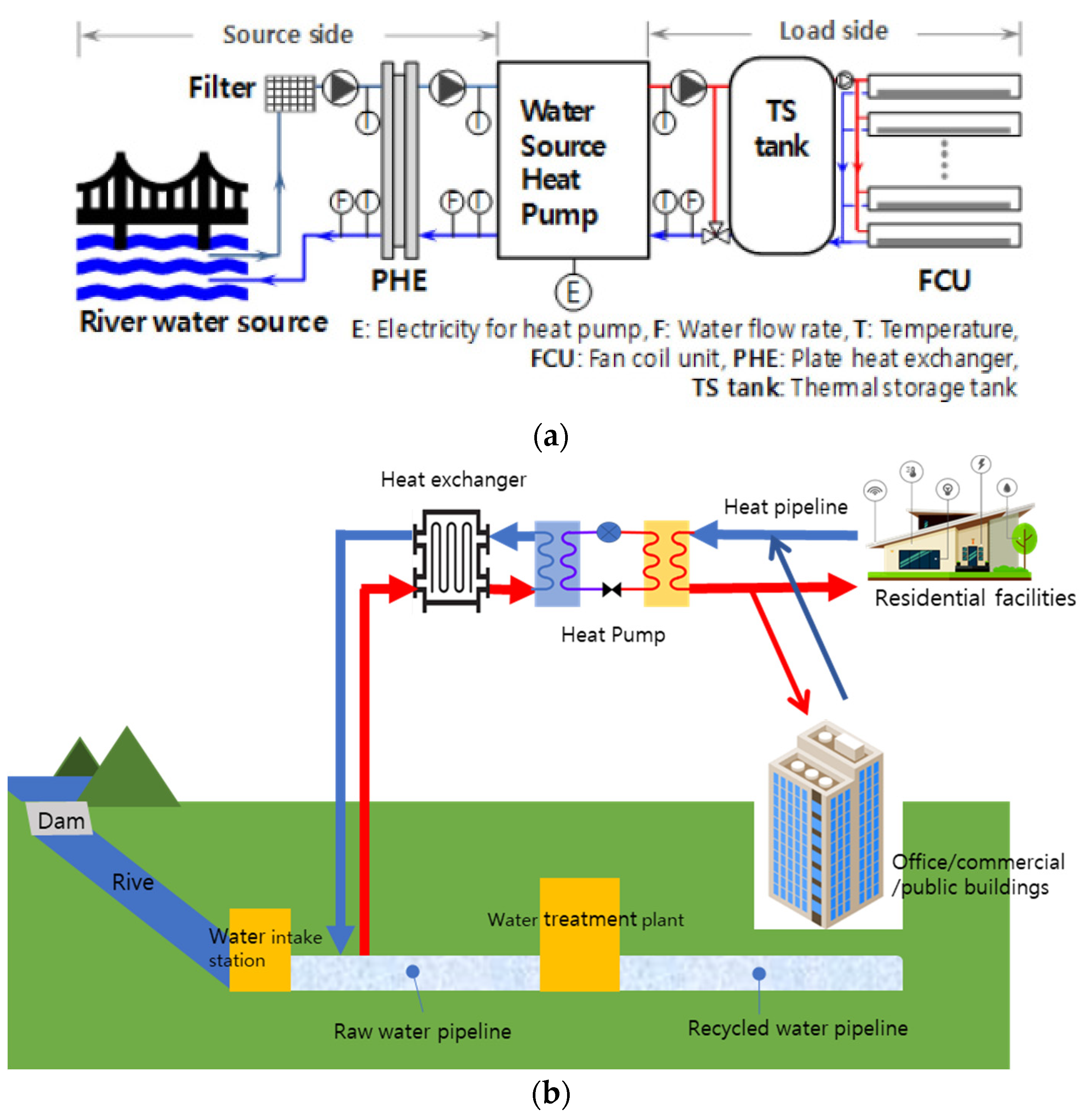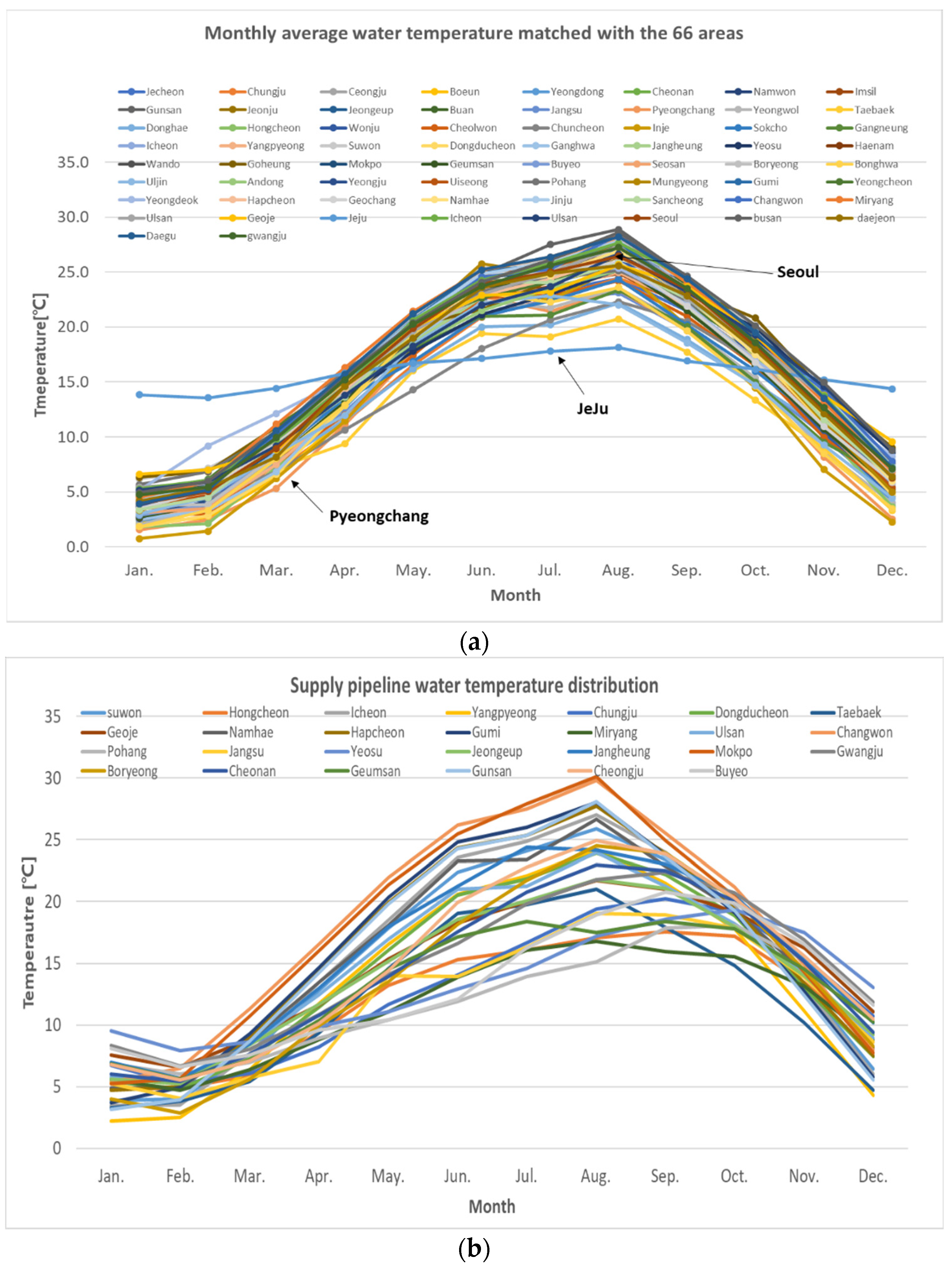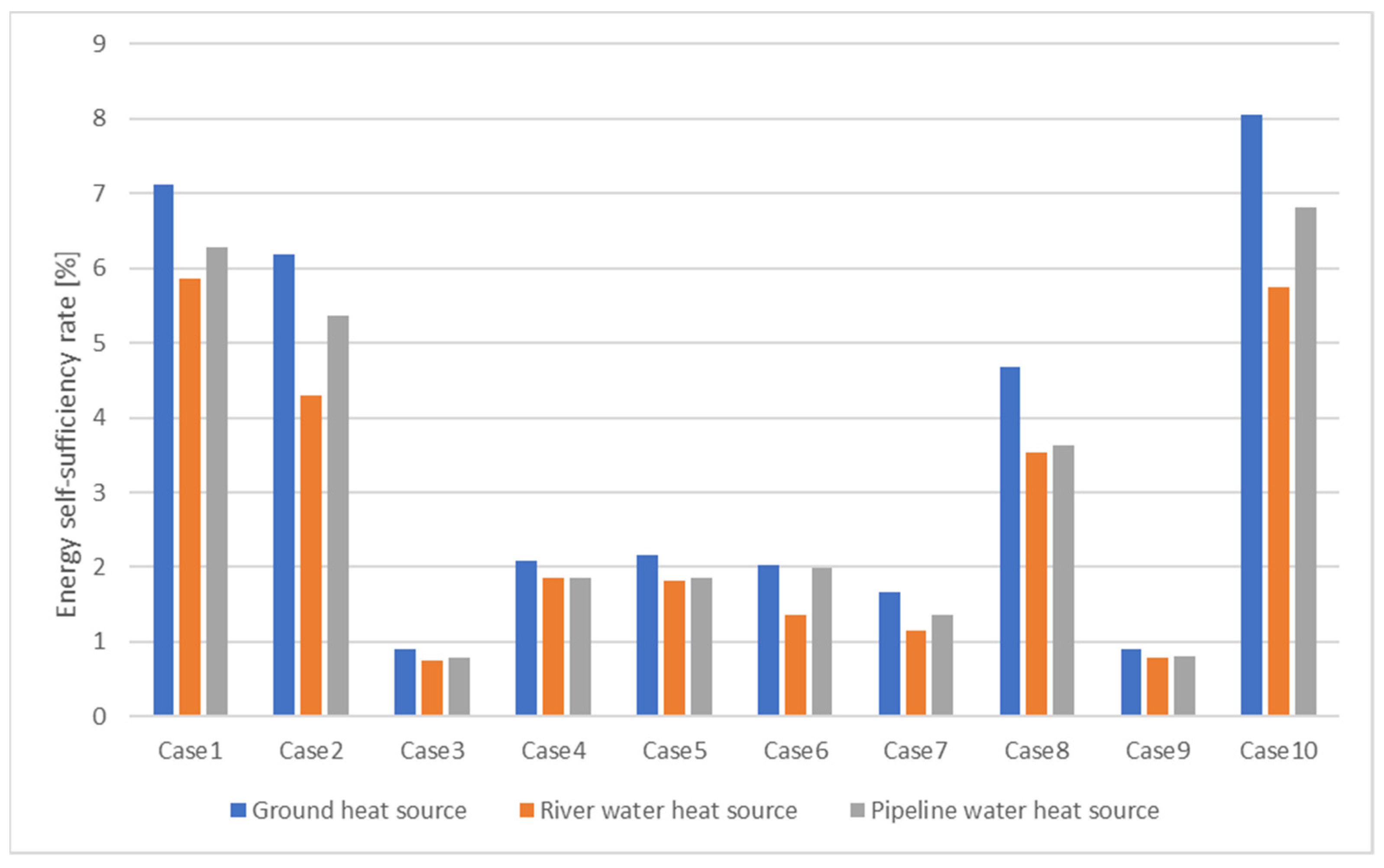Constructing a Database of Reference Hydrothermal Sources for a Zero-Energy Building Certification Rating in South Korea and Analyzing the Renewable Energy Self-Sufficiency Rate Achieved by Water-Source Heat Pumps
Abstract
:1. Introduction
2. Materials and Methods
2.1. Seasonal Temperature Analysis of Hydrothermal Sources
2.1.1. Architecture of a WSHP
2.1.2. Relationship between Water Temperature and Outside Temperature
2.1.3. Seasonal Temperature Data Collection of River Water Heat Sources
2.1.4. Methodology for Deriving Pipeline Data
2.2. ECO2-Based Calculation of Geothermal/Hydrothermal Energy Self-Sufficiency Rate
2.2.1. ECO2 Program
2.2.2. Renewable Energy Self-Sufficiency Rate Calculation Standard for Evaluation Purposes
2.2.3. Selection of WSHPs
3. Results and Discussion
3.1. Extraction of Reference Meteorological Data from River and Pipeline Water
3.2. Self-Sufficiency Rates of WSHPs by ECO2 Rating
4. Conclusions
- (1)
- Compared to outside air temperature, water heat sources showed no significant variations in the daily average and hourly temperatures. Based on the findings of previous research, stating that, in areas with no hourly water temperature data, system design is possible with daily or monthly average data, river water data provided by each region were taken and averaged, and a reference hydrothermal source database was constructed by matching the averaged data with the currently available standard meteorological data in 66 areas for them to be linked to the selected building rating area in the ECO2 program.
- (2)
- Among ZEB-certified buildings, those with GSHPs were selected. Applying the standard meteorological data and reference hydrothermal data to the ECO2 rating yielded the following findings: in all cases (reference: Seoul), GSHPs had a higher self-sufficiency rate than WSHPs (ground source > pipeline water > river water), whereby GSHPs outperformed WSHPs by 11–33%, possibly because the water source temperature in Seoul is higher in summer and lower in winter, compared to the constant annual ground-source temperature of 15 °C. Pipeline water appeared to be less sensitive than river water, depending on single-standard hydrothermal source data.
- (3)
- A one-case regional comparison, which was performed in the cold (Jeongseon), central (Seoul), and southern (Jeju) regions to estimate the regional differences, revealed that in areas with good reference hydrothermal conditions (i.e., higher water temperature in winter and lower water temperature in summer, compared to the geothermal temperature), WSHPs yield a higher self-sufficiency rate than GSHPs.
Supplementary Materials
Author Contributions
Funding
Data Availability Statement
Conflicts of Interest
References
- United Nations Environment Programme, Global Alliance for Buildings and Construction. Towards a Zero-Emissions, Efficient and Resilient Buildings and Construction Sector, 2020 Global Status Report for Buildings and Construction. 2020, pp. 1–7. Available online: https://globalabc.org/sites/default/files/inline-files/2020%20Buildings%20GSR_FULL%20REPORT.pdf (accessed on 17 December 2022).
- Kim, Y.; Yu, K. Study on the certification policy of zero-energy buildings in Korea. Sustainability 2020, 12, 5172. [Google Scholar] [CrossRef]
- Hunt, J.D.; Byers, E.; Sánchez, A.S. Technical potential and cost estimates for seawater air conditioning. Energy 2019, 166, 979–988. [Google Scholar] [CrossRef] [Green Version]
- Kindaichi, S.; Nishina, D.; Wen, L.; Kannaka, T. Potential for using water reservoirs as heat sources in heat pump systems. Appl. Therm. Eng. 2015, 76, 47–53. [Google Scholar] [CrossRef]
- Lund, R.; Persson, U. Mapping of potential heat sources for heat pumps for district heating in Denmark. Energy 2016, 110, 129–138. [Google Scholar] [CrossRef]
- Schibuola, L.; Scarpa, M. Experimental analysis of the performances of a surface water source heat pump. Energy Build. 2016, 113, 182–188. [Google Scholar] [CrossRef]
- Liu, Z.; Tan, H.; Li, Z. Heating and cooling performances of river-water source heat pump system for energy station in shanghai. Procedia Eng. 2017, 205, 4074–4081. [Google Scholar] [CrossRef]
- Wang, Y.; Wong, K.K.L.; Liu, Q.; Jin, Y.; Tu, J. Improvement of energy efficiency for an open-loop surface water source heat pump system via optimal design of water-intake. Energy Build. 2012, 51, 93–100. [Google Scholar] [CrossRef]
- Lv, N.; Zhang, Q.; Chen, Z.; Wu, D. Simulation and analysis on the thermodynamic performance of surface water source heat pump system. Build. Simul. 2017, 10, 65–73. [Google Scholar] [CrossRef]
- ASHRAE. ASHRAE Handbook: Handbook HVAC Applications; American Society for Heating, Refrigerating, and Air Conditioning Engineers Inc.: Atlanta, GA, USA, 2011. [Google Scholar]
- Zhu, N.; Hu, P.; Wang, W.; Yu, J.; Lei, F. Performance analysis of ground water-source heat pump system with improved control strategies for building retrofit. Renew. Energy 2015, 80, 324–330. [Google Scholar] [CrossRef]
- Sciacovelli, A.; Guelpa, E.; Verda, V. Multi-scale modeling of the environmental impact and energy performance of open-loop groundwater heat pumps in urban areas. Appl. Therm. Eng. 2014, 71, 780–789. [Google Scholar] [CrossRef]
- Nam, Y.; Ooka, R. Numerical simulation of ground heat and water transfer for groundwater heat pump system based on real-scale experiment. Energy Build. 2010, 42, 69–75. [Google Scholar] [CrossRef]
- Liang, J.; Yang, Q.; Liu, L.; Li, X. Modeling and performance evaluation of shallow ground water heat pumps in Beijing plain, China. Energy Build. 2011, 43, 3131–3138. [Google Scholar] [CrossRef]
- NEDO. Survey for Preparation of New Energy Technology Development Related Data Collection (Unused Energy); Investigation Report NEDO-P-9810; Japan Systems Development Laboratory: Kawasaki City, Japan, 1998; pp. 1–66. [Google Scholar]
- Jung, J.; Nam, J.; Jung, S.; Kim, J.; Kim, H. Feasibility Study on the Use of River water Hydrothermal Energy in Korea: (1) Estimation of the Permitted Standard Discharge and Determination of the Potential water Intake Area. New Renew. Energy 2018, 12 Vol.14, 27–37. [Google Scholar] [CrossRef]
- Sohn, B. An Applicability Analysis of River Water Source Heat Pump System Using EnergyPlus Simulation; Korean Society for Geothermal and Hydrothermal Energy (KSGHE): Seoul, Republic of Korea, 2022; Volume 18, pp. 10–21. [Google Scholar]
- Water Environment Information System’s Water Quality Measurement Network Data. Available online: https://water.nier.go.kr/web/waterMeasure?pMENU_NO=2 (accessed on 3 August 2022).
- Jo, J.-H. A Study on Evaluation Criteria and Evaluation Tool for Energy Performance of Internal and External Building, Construction Technique/Sangyong, Special Project II—Zero Energy Building Policies and Trends of Internal and External. Building 2017, 23. Available online: http://www.auric.or.kr/User/Rdoc/DocRdoc.aspx?BrsDataBaseName=RDOC&PrimaryKey=350201&DBNM=RDCR#.XvGVO3duKUl (accessed on 20 April 2020).
- Kim, Y.; Jang, H.K.; Yu, K.H. Study on extension of standard meteorological data for cities in South Korea using ISO 15927–4 ISO 15927-4. Atmosphere 2017, 8, 220. [Google Scholar] [CrossRef]






| DB Collection | DB Processing | DB Matching | ||
|---|---|---|---|---|
| ▶ | ▶ | |||
|
|
|
| No. | Use | Structure | Gross Area | Region | Ground-Source Heat Pump Capacity (kW) | Primary Pump Power (W) | Geothermal Expansion Tank Volume (L) |
|---|---|---|---|---|---|---|---|
| 1 | Non-residential (Sports) | RC, SF, SRC a | 4517.54 | Gyeonggi-do (Gimpo) | 354.90 | 14,700 | 200 |
| 2 | Non-residential (Offices) | RC | 7971.42 | Seoul | 732 | 22,000 | 1000 |
| 3 | Non-residential (Culture/Gathering) | RC, SRC | 28,442.65 | Gyeongsangbuk-do (Andong) | 1071.582/ 1170.036 | 33,000 /33,000 | 1600 /1600 |
| 4 | Non-residential (Accommodation) | RC | 107,220.55 | Incheon | 978.419/313.464/903.156/246.909 | 18,500/7500/18,500/7500 | 800/800/800/800 |
| 5 | Non-residential (Education) | RC | 9512.81 | Sejong | 463.62 | 16,500 | 300 |
| 6 | Non-residential (Offices) | RC | 10,960.00 | Seoul | 402.807 | 16,500 | 300 |
| 7 | Non-residential (Education/Research) | RC, SF | 3207.68 | Gangwon-do (Wonju) | 166.5 | 11,100 | 200 |
| 8 | Non-residential (Education/Research) | SRC, M, LSF b | 2925.66 | Chungcheongbuk-do (Cheongju) | 105.210 | 5900 | 200 |
| 9 | Non-residential (Offices) | SRC | 28,442.65 | Gyeongsangbuk-do (Andong) | 1170.036 | 33,000 | 1600 |
| 10 | Non-residential (Offices) | SRC | 3760.17 | Chungcheongbuk-do (Cheongju) | 1071.582 | 33,000 | 1600 |
| (a) River water heat source data | ||||||||||||
| Region | Jan | Feb | Mar | Apr | May | Jun | Jul | Aug | Sep | Oct | Nov | Dec |
| Seoul | 3.9 | 5.0 | 9.0 | 14.6 | 19.9 | 23.9 | 25 | 26.5 | 23.5 | 18.2 | 12.5 | 6.3 |
| Jeju | 13.8 | 13.5 | 14.4 | 15.8 | 16.7 | 17.1 | 17.8 | 18.1 | 16.9 | 16.2 | 15.2 | 14.4 |
| Jeongseon | 1.6 | 2.4 | 5.3 | 11.1 | 17.7 | 22.8 | 21.4 | 23.4 | 19.7 | 15 | 8.2 | 2.5 |
| (b) Regional raw water heat source data | ||||||||||||
| Jan | Feb | Mar | Apr | May | Jun | Jul | Aug | Sep | Oct | Nov | Dec | |
| 5.6 | 5.1 | 7.8 | 11.5 | 15.7 | 19.2 | 21.0 | 22.9 | 21.5 | 18.9 | 14.2 | 8.6 | |
Disclaimer/Publisher’s Note: The statements, opinions and data contained in all publications are solely those of the individual author(s) and contributor(s) and not of MDPI and/or the editor(s). MDPI and/or the editor(s) disclaim responsibility for any injury to people or property resulting from any ideas, methods, instructions or products referred to in the content. |
© 2023 by the authors. Licensee MDPI, Basel, Switzerland. This article is an open access article distributed under the terms and conditions of the Creative Commons Attribution (CC BY) license (https://creativecommons.org/licenses/by/4.0/).
Share and Cite
Kim, Y.; Yu, K.-H. Constructing a Database of Reference Hydrothermal Sources for a Zero-Energy Building Certification Rating in South Korea and Analyzing the Renewable Energy Self-Sufficiency Rate Achieved by Water-Source Heat Pumps. Energies 2023, 16, 543. https://doi.org/10.3390/en16010543
Kim Y, Yu K-H. Constructing a Database of Reference Hydrothermal Sources for a Zero-Energy Building Certification Rating in South Korea and Analyzing the Renewable Energy Self-Sufficiency Rate Achieved by Water-Source Heat Pumps. Energies. 2023; 16(1):543. https://doi.org/10.3390/en16010543
Chicago/Turabian StyleKim, Yeweon, and Ki-Hyung Yu. 2023. "Constructing a Database of Reference Hydrothermal Sources for a Zero-Energy Building Certification Rating in South Korea and Analyzing the Renewable Energy Self-Sufficiency Rate Achieved by Water-Source Heat Pumps" Energies 16, no. 1: 543. https://doi.org/10.3390/en16010543





